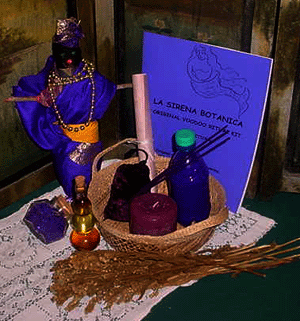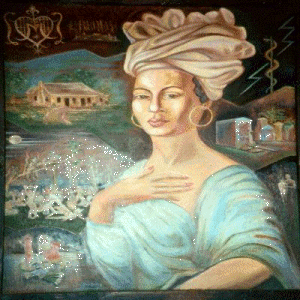|
Voudounaka voodoo One of history's worst-kept secrets is that white people have done a lot of bad things to black people, especially over the last several centuries. Many of these bad things involved the practice of slavery, in which various European-type white people with guns kidnapped many black people without guns and took them all over the world to do unpleasant heavy labor.
One of history's worst-kept secrets is that white people have done a lot of bad things to black people, especially over the last several centuries. Many of these bad things involved the practice of slavery, in which various European-type white people with guns kidnapped many black people without guns and took them all over the world to do unpleasant heavy labor. One place this happened was Haiti. Christopher Columbus, who sailed the ocean blue in 1492, was famous for discovering America, but in the process, he also stumbled across Haiti, which had been doing just fine on its own prior to this development. When the French took control of the island in the 17th century, the Spaniards had exterminated the happy native population, which necessitated the import of non-white people for the white people to abuse. The French brought slave labor from the West Coast of Africa. The French used these slaves to harvest the island's rich crops of sugar, coffee and cocoa. Naturally, the slaves didn't care for this arrangement, especially in light of the particularly sadistic practices of Haiti's slavemasters. The sadism was their first mistake; their second mistake was a failure to Christianize their captives. The Haitian slave labor force brought with it the native religions of Africa, which the oppressed people quickly retooled to fit their circumstances. Since their circumstances included a lot of whipping and rape, the new religion took on a pretty dark aspect. Voudoun (known by its slang name of voodoo or hoodoo) took the basic cosmology of its African roots and added a lot of "ways to stick it to the Man," a goal for which it proved extraordinarily effective. In 1791, the slaves revolted and took over the island; by the beginning of the 19th century, Haiti was the first black-controlled nation in the hemisphere.
Voudoun has a complex cosmology that deals with the workings of the universe, but for some reason, people are always more interested in the sticking pins in dolls part. Nevertheless... Voudoun involves a form of ancestor worship. Practitioners believe that the souls of ancestors stick around to help out, if properly honored after death. Eventually, if they stick around long enough and are treated well enough by the living, these deads souls are promoted to the position of loa, which is basically a deity with powers and a personality. Voodoo believers routinely speak with dead souls, while more elaborate ceremonies are presided over by houngans, male priests, and mambos. Houngans also serve as doctors and father-figures, but voudoun is remarkably democratic and personal, as religions go.
Although loas have been known to come calling unexpectedly, they generally prefer to manifest themselves during ritual. The chief method of invoking a loa involves ritual dancing. When the participant dances to the point of exhaustion, a loa may enter and dispense advice, perform a service, or tell a few dirty jokes. One of the best-known loa is the one that tells the dirty jokes, not surprisingly. Papa Ghede is the loa who guards the crossroads to the underworld. He wears a top hat and enjoys cigars. He's also known as the loa of eroticism. One way to detect the presence of Ghede is to follow the string of really bad dirty jokes, along the lines of "Hey, baby, how's your clit doing? I've got a big ole schlong here to take care of it, if you're having any problems." Since this passes for humor among not insignificant portions of the college-going population, the more reliable test of Ghede's is to spit rum into the eyes of the person in question. If he runs away screaming and suffers permanent blindness, it probably wasn't Ghede. There are many other loa of lesser and greater import; some of them overlap in ways that make the heads of the uninitiated hurt, so they won't be detailed here. For instance, Papa Ghede is sometimes also Baron Samedi, who has more of a "grim reaper" presentation than the typical "George-Burns-on-crack" stylings of Ghede, and he's also Legbe sometimes, but not at other times. There are also multiple loas with Legbe or Ghede as part of their names. Others loas include Erzulie, the female loa of beauty, and Ogoun, the warrior loa. Ogoun was a key figure during the Haitian slave revolts, often possessing (or "riding") battlefield leaders and guiding them to victory. About 98% of you have been plowing through this article solely to read about the voodoo doll, so let's not waste any more time.
Everyone pretty much grasps the basic principle of the voodoo doll. It's a little effigy made of cloth or wax, fashioned to resemble an individual regarding whom one wishes to employ hoodoo. The doll is greatly enhanced by the addition of something personal belonging to the individual in question, ideally some hair or fingernail clippings, although it can be difficult to discreetly obtain these items. (Granted, you can snag them from live-in lovers pretty easily, but it's generally easier to browbeat these people into submission than work black magic against them.) So you've got your voodoo doll, but what do you do with it? Bearing in mind all that life-affirming stuff referenced above, the most obvious thing to do with a voodoo doll is stick pins in it. Aside from the viscerally satisfying nature of this activity, the theory is that if you constructed your doll correctly, the pin pricks will manifest themselves on the subject of your hoodoo as sharp stabbing pains, boils or other maladies. One can also apply less vicious forms of stimulation to the doll if the goal is to win the individual's affections or convince them to make a real estate investment. A heavily Christianized version of Voudoun known as Santeria is even creepier and weirder than Voudoun, but that's another article entirely. Other voodoo rituals involve colorful animal sacrifices (a practice shared by just about every deity-oriented religion except Christianity), the aforementioned dancing, blessings and consecrations. Like the Masons and the OTO, the top-level voudoun rituals, magickal practices and secrets of the universe are strictly for initiated insiders. Unlike the Masons and the OTO, Voudoun practitioners are actually quite good at keeping their secrets secret, so it's unlikely you'll be reading any here. Dammit.
No sensationally exploitative discussion of Haitian voodoo would be complete without talking about the zombies. Go, zombies! According to lore, houngans known the secret of waking and reanimating the dead. This isn't a fun quality-of-life resurrection it's more of a Frankenstein thing, complete with shambling and violent tendencies. The reanimated corpse is called a zombie. It follows orders reasonably well, doesn't complain and, well, it's not quite clear if it keeps decomposing while it's about its tasks, but we presume not. The zombie issue has been the subject of much controversy over the years. Some scientists have proposed that there is no such thing as a zombie, others have suggested zombie-like beings could be created by poisoning men with toxin extracted from a puffer fish. Some non-scientists say "It's magic" and don't worry about it so much. If you're at a cocktail party and someone introduces themselves to you as a Voudoun initiate, it's a very good idea not to mention zombies and voodoo dolls, because it's almost certain no good will come of it. If you're lucky, you'll get one of these oversensitive New Age voudouns who will insist that there are no such thing as zombies and voodoo dolls, and that you have been the victim of bigoted misinformation, and blah, blah, blah, until your evening has been ruined. You're most likely to hear this kind of thing from trendy young white urban Voudoun wannabes. If you're unlucky, you might manage to offend someone who has actually been clued in about the zombies and voodoo dolls. While there are no direct reports from the front lines, I presume that shambling around performing manual labor and decomposing all over the place is no fun at all.
|
 Voudoun also traveled with the French slave force to New Orleans, but the (slightly) less repressive conditions there allowed the practice to integrate more smoothly with the society, thus bypassing that particular revolution (in favor of a civil war later). In New Orleans, through the 19th and 20th centuries, voodoo became a major tourist attraction, as all religions eventually do, promoted in large part by Marie Laveau, a notorious voodoo priestess, or mambo, who appears to have had more in common with the showboat posturing of
Voudoun also traveled with the French slave force to New Orleans, but the (slightly) less repressive conditions there allowed the practice to integrate more smoothly with the society, thus bypassing that particular revolution (in favor of a civil war later). In New Orleans, through the 19th and 20th centuries, voodoo became a major tourist attraction, as all religions eventually do, promoted in large part by Marie Laveau, a notorious voodoo priestess, or mambo, who appears to have had more in common with the showboat posturing of  Loas manifest themselves primarily through possession, an ecstatic process which is completely undiscriminating about who gets to play. Unlike Christians, a Voudoun believer doesn't freak out and call an
Loas manifest themselves primarily through possession, an ecstatic process which is completely undiscriminating about who gets to play. Unlike Christians, a Voudoun believer doesn't freak out and call an  You probably don't want to hear about how the whole voodoo doll thing is way overblown, that most respectable voodoo practitioners don't use them, that even less respectable practitioners didn't use them that much, and that voudoun is a life-affirming and positive spiritual path (just like
You probably don't want to hear about how the whole voodoo doll thing is way overblown, that most respectable voodoo practitioners don't use them, that even less respectable practitioners didn't use them that much, and that voudoun is a life-affirming and positive spiritual path (just like  Well, except for the
Well, except for the